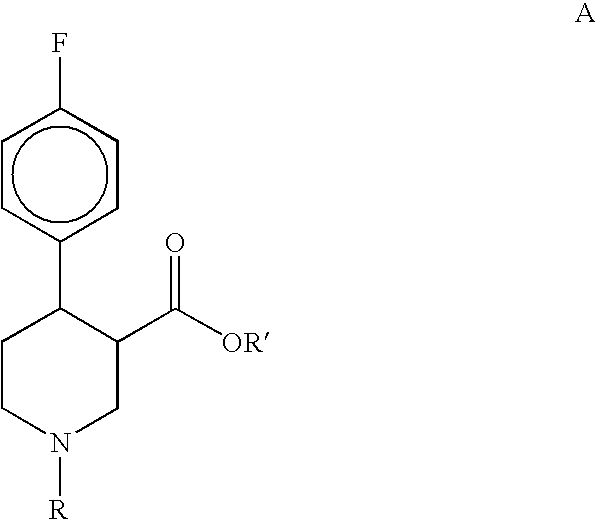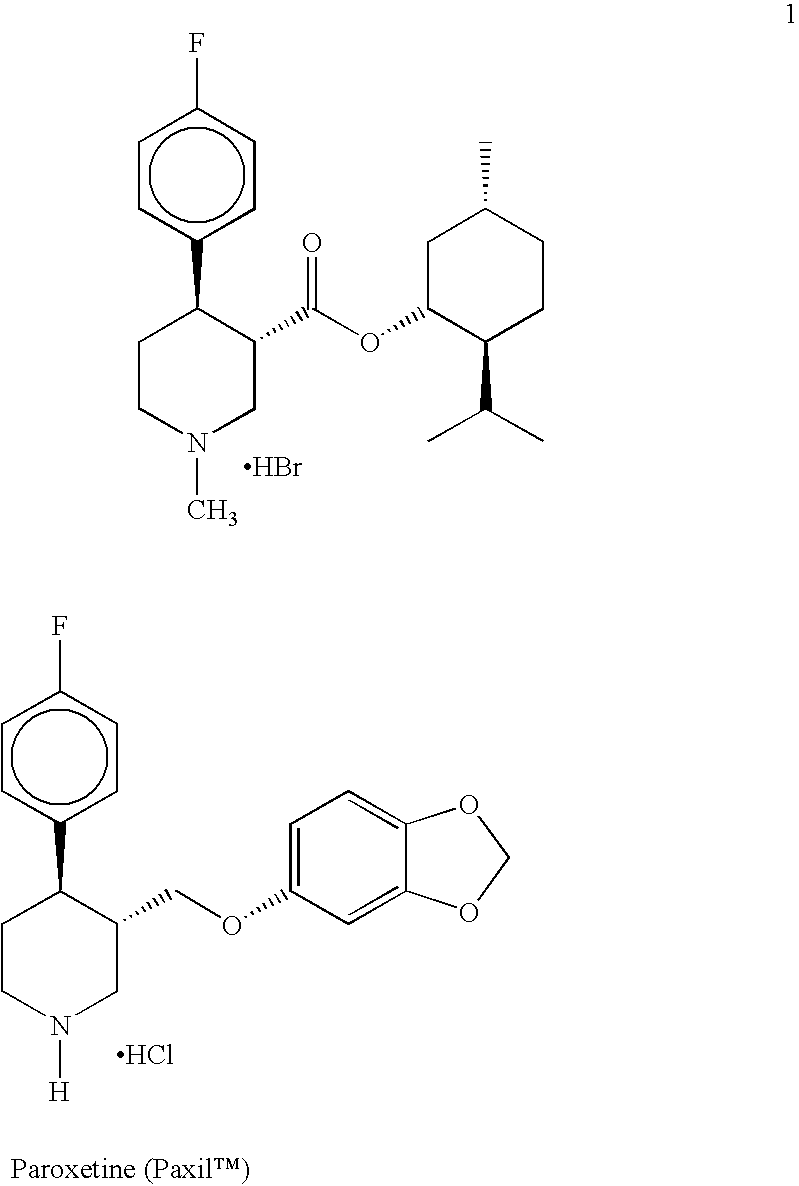Preparation of 4-(4-fluorophenyl)-N-alkylnipecotinate esters, 4-(4-fluorophenyl)-N-arylnipecotinate esters and 4-(4-fluorophenyl)-N-aralkylnipecotinate esters
- Summary
- Abstract
- Description
- Claims
- Application Information
AI Technical Summary
Benefits of technology
Problems solved by technology
Method used
Image
Examples
example 2
Preparation of (−)-menthyl (3S,4R)-trans-4-(4-fluorophenyl)-N-methylnipecotinate hydrobromide (1) in DBE and copper chloride
[0039]A round bottom flask was charged with 4-fluorophenylmagnesium bromide (1M in THF, 56 mL, 0.0560 mol) and the flask was cooled to −3 to 1° C. and kept under a nitrogen atmosphere. To this mixture was added cuprous chloride (0.40 mg, 4.0 mmol) followed by (1R,2S,5R)-(−)-menthyl arecoline (11.2 g, 40.1 mmol) in DBE (total volume of solution=68 mL) over a 35 minute period. The cooling bath was removed and the solution was warmed to room temperature (23° C.) and the reaction was kept at this temperature a further 3 hours. It was then cooled to 10° C. and saturated aqueous ammonium chloride (55 mL) was added while maintaining the temperature below 17° C. The mixture was filtered through a Celite pad and the filter cake washed with DBE (1×10 mL) and the filtrate was transferred to a separatory funnel. The aqueous layer was removed and back-extracted with DBE (2×...
example 3
Preparation of (−)-menthyl (3S,4R)-trans-4-(4-fluorophenyl)-N-methylnipecotinate hydrobromide (1) in DBE, copper chloride and 30° C. Reaction Temperature for the Grignard Addition
[0040]The same procedure as the one described in example 2 was followed except that the round bottom flask containing 4-fluorophenylmagnesium bromide (1M in THF, 56 mL, 0.0560 mol) and cuprous chloride (0.40 mg, 4.0 mmol) was maintained at 27–32° C. during the addition of the (1R,2S,5R)-(−)-menthyl arecoline substrate (30 minutes) and subsequent maintain time of 2 hours. The yield of (−)-menthyl (3S,4R)-trans-4-(4-fluorophenyl)-N-methylnipecotinate hydrobromide was 5.03 g (27.5% yield from (1R,2S,5R)-(−)-menthyl arecoline) and the material had the same 1H NMR as the product from example 1.
example 4
Preparation of (−)-menthyl (3S,4R)-trans-4-(4-fluorophenyl)-N-methylnipecotinate hydrobromide (1) in tetrahydrofuran (THF)
[0041]A round bottom flask is charged with 4-fluorophenylmagnesium bromide (1M in THF, 56 mL, 0.0560 mol) and the flask was cooled to −10 to −5° C. and kept under a nitrogen atmosphere. To this mixture was added a solution of (1R,2S,5R)-(−)-menthyl arecoline (11.2 g, 40.1 mmol) in THF (60 mL) over a 1.5 hour period. The cooling bath was removed and the solution was warmed to 15° C. and the reaction was kept at this temperature a further 8 hours. It was then quenched using saturated aqueous ammonium chloride (75 mL) while maintaining the temperature below 17° C. The mixture was filtered through a Celite pad and the filter cake washed with toluene (1×10 mL) and the filtrate was transferred to a separatory funnel. The aqueous layer was removed and back-extracted with toluene (2×50 mL). The combined organic layers were concentrated to a weight of 55 g and cooled to −...
PUM
| Property | Measurement | Unit |
|---|---|---|
| Fraction | aaaaa | aaaaa |
| Fraction | aaaaa | aaaaa |
| Fraction | aaaaa | aaaaa |
Abstract
Description
Claims
Application Information
 Login to View More
Login to View More - R&D
- Intellectual Property
- Life Sciences
- Materials
- Tech Scout
- Unparalleled Data Quality
- Higher Quality Content
- 60% Fewer Hallucinations
Browse by: Latest US Patents, China's latest patents, Technical Efficacy Thesaurus, Application Domain, Technology Topic, Popular Technical Reports.
© 2025 PatSnap. All rights reserved.Legal|Privacy policy|Modern Slavery Act Transparency Statement|Sitemap|About US| Contact US: help@patsnap.com



